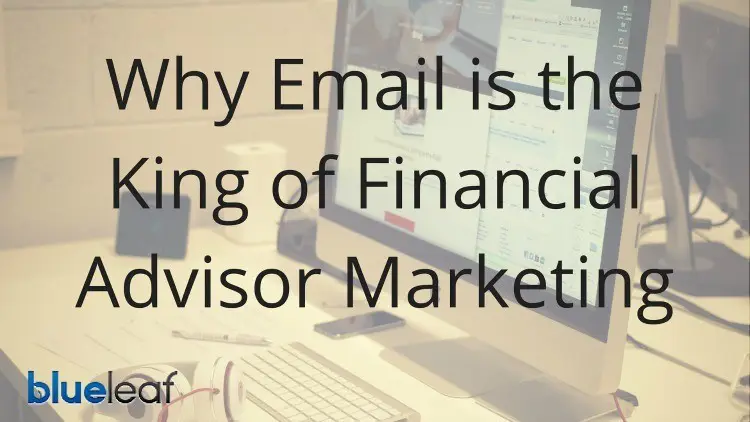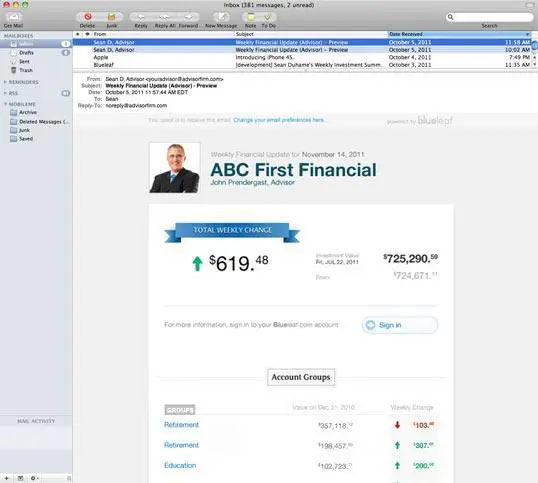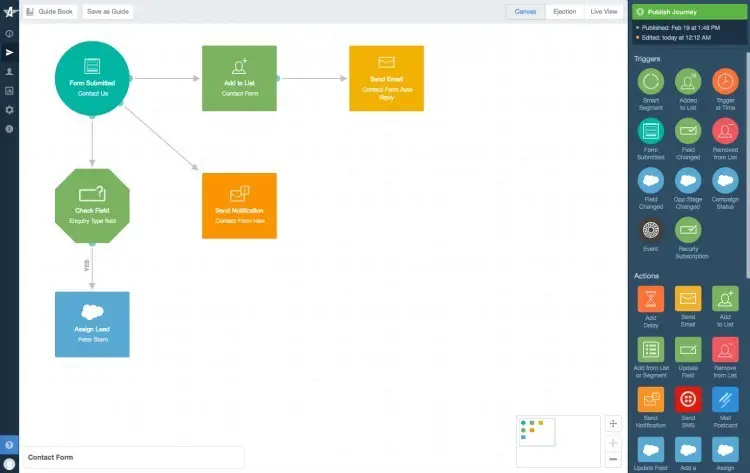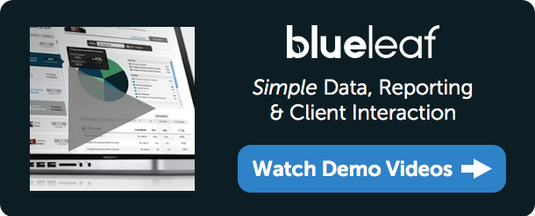Last Updated on July 20, 2020 by Raaj Trambadia
Financial advisor marketing is hard. There are endless options but which strategies work?
The answer is simple. Focus on email for the best return on investment.

Email might seem old-fashioned, but it still works better than any other channel. Just why is that?
Email is personal
While there is a lot of buzz around social media, email remains the most personal medium. The inbox is home turf made even more available with smartphones. The email content needs to be personal and relevant to build trust.
Email gets the best return on your time
The Direct Marketing Association (DMA) found that email marketing delivers a return of 4,300%. The combination of low time investment and good results is very compelling. The increased availability of low-cost email automation makes the email opportunity, even more, compelling.
Effective email content builds a relationship with your audience through intriguing subject lines (getting your messages opened), a distinctive voice ( a personality that encourage reading and action), and quality, relevant content. The right content encourages sharing and referrals.
Email is the most natural fit with the traditional financial advisor marketing model built around referrals.
Here’s how to get the most from email marketing.
1. Build relationships faster with a better email strategy
a. 12 touches a year isn’t going to cut it
A recent Morningstar study asked how their clients prefer to be emailed. The survey found that 30.4% of clients prefer weekly emails from their advisor with 36.6% preferring to receive them monthly. Only 19.9% prefer emails quarterly and a mere 9.4% prefer them annually. The research is clear. Clients want to be emailed, and often.
Blueleaf’s own behavioral data shows that over 60% of clients will open and read a relevant weekly email about their situation and almost 90% will open that same email once per month.
In fact, we’ve found that advisors who are the most successful in growing their business will email their clients even MORE than once per week.
We spoke with Jason Wenk, Founder and President of Retirement Wealth Advisors. His firm is growing 50% per year. Jason reported reaching out to each client at least 150-200 times per year. This translates into a minimum of 12.5 touches per month, 4 of which are handled automatically with his weekly Blueleaf email.

b. Deliver value with every communication
Remember that a touch can be delivered in various ways: in person, via email, phone, social media, or traditional mail. By mixing push and pull methods like email and blogging consume what they like and happily skip the rest. This kind of frequent contact powerfully reminds clients of your value even if some of the content is “ignored” by some clients.
The more clients feel you’re delivering value to them, the more likely they will want to share that value. Continually delivering value also means more loyalty. Once you’ve invested in a client relationship, you have to protect your investment if you want to prosper in the long run.
2. Create a Communication Calendar
A Communication Calendar lets you plan out the types of content you want to send each month, so when a new month arrives, you’re ready with a plan.
Click on this link and then copy the file to get your own version of our Content Calendar in Google Docs.
Your content should address the top issues that your clients and prospects have. Their biggest concerns are usually around maintaining their lifestyle in retirement and supporting their family. Developing your content should be based on client priorities not your own.
The free Persona App tool can help you with the questions to ask.
You can validate your research by checking keyword search volume in Google’s free keyword planner. You have to sign up for an Adwords account to access it. Here’s a video to show you how to use the Keyword Planner tool.
You can also check how the topic is trending using Google Trends.
3. Optimize your emails
Effective email has the following attributes.
a. Personalized
We don’t mean “Hi [INSERT NAME HERE]”. Forced familiarity can be counterproductive. Even with clients, personalization with their name will not get you far.
Personalization is most effective when you are used in a meaningful way. Blueleaf’s weekly emails are powerful in this regard since they provide a real-time summary of the client’s current financial picture. This is a big factor in the remarkably high engagement that these emails get.
Using research to make sure that your content addresses your client’s big issues can generate high engagement levels also.
b. Segmented
Related to personalization, most email programs allow you to segment your lists based on specific criteria. At a minimum, segment your lists between clients and prospects. This gives you an opportunity to focus on generating referrals from your clients while seeking different engagement options like social follows with prospects.
c. Subject line
Research shows short subject lines (70 characters) get the highest open rate. Driving Opens means that you are trying to increase awareness of your content. In other words, you want them to read the email. Focusing on clicks is about generating a response or action such as visiting your blog. The success of the Obama campaign’s legendary “Hey” subject line makes super short subject lines worth a test.
d. When to send
Research shows that emails sent in the morning will have slightly higher open rates. So mornings are a good time to send out something short, like an invitation to an event that people can scan as they prepare for their day.
The late afternoon has been shown to have a higher click through rate, which means this is a good time to send out a survey or teaser for a new blog post.
The idea is to think about your client’ s day and tailor what you send and when you send it to achieve optimal open and click through rates. Your persona research will help with this.
e. Straight forward copy
A simple, attention-grabbing and likable message increases response and click through. An eye-catching call-to-action with a “what’s in it for me” message is a key element. The recipient should know exactly what they are going to get when they click.
Try running your copy through Hemingway Editor to help you simplify. Just copy your text into the web editor and the application will highlight issues.
f. Ask a question
When you read a question in a marketing message, do you always think of an answer? Probably not. But a question still registers on a subconscious level and creates engagement. For example, you could start an email by saying, “Wondering if you’ll ever be able to retire?” or “Worried about the rising cost of education?” or “Should you buy or rent?”
g. Use other people’s content
No one expects you to write like a Pulitzer Prize Winner. You’re an advisor who advises; let the writers write. As long as you give an author credit, feel free to summarize an article and link to it rather than write everything from scratch. Your clients will appreciate you sending them a helpful article and be happy that you spend most of your time managing their money.
h. Measure the results
You’ve spent time and energy planning and running this nurturing campaign, so be sure to measure the responses you get! Watch how many clients open the email (effect of subject line or time you send it) and how many of them click on links (effect of your messaging or the content’s relevance to their individual situation). Again, a lot of this results tracking and reporting is built into the email tools mentioned above.
4. Check out this email example
a. From line: John at Blueleaf (john@blueleaf.com)
Try to avoid sending emails from a generic company email address (ex: info@advisor.com). The person or company an email comes from should be relevant to the person receiving it. When they recognize your name and company, they’ll be much more likely to open the email.
b. Subject line: A Step by Step Guide to …
For example, a standard subject line may be: “Quarterly Newsletter”. A better subject line is “Advisor X’s Q3 Insights for the Aggressive Investor”. Word to the wise: There is such a thing as being too compelling, though, so be careful.
c. Sample email
Subject Line: Top 5 Money Mistakes College Kids Make
************************
Hi Bob and Ann,
How are you enjoying this beautiful summer weather? I recently got back September approaching and students preparing to head back to college, I thought it’d be a great time to share this helpful article:
“Top 5 Money Mistakes College Students Make”
QJ
Best,
Your Advisor
Think that this could be helpful people that you know?
Forward to a friend
************************
5. Use MailChimp’s forward to a friend feature
There are a number of email programs available. One of the biggest is MailChimp. MailChimp includes a “refer a friend” feature. Using this feature as two advantages.
Unsubscribe issues
The Forward to a Friend link does not forward the email that your client received. This prevents the new recipient from accidentally unsubscribing your client.
Reporting
Forward to a Friend will show in your campaign report so you can see how often your email was forwarded and how often those forwarded emails were opened. You won’t see this if a client simply forwards their email.
Here’s how it works.
Step 1: Add a refer a friend form for your list
Follow these instructions.
Step 2: Add the link to your email
The MailChimp forward a friend guide explains the options. The easiest is to use the link tool by highlighting the text (e.g. “Forward to a Friend”, click on the icon, select the web link and paste *|FORWARD|* in the field.
Here’s a link to a refer a friend form that we created.
You can customize with your own design and copy.
Step 3: The client’s friend receives an email
a. Personalized subject
The subject line is personalized to increase open rates.
[Client’s name] is forwarding an email to you
b. Personalized email
The client personalized the email via the form.
Here’s an example of the email that the client receives. You can edit the copy.
Step 4: Promote the refer a friend program
The refer a friend link option as a socially acceptable way for clients to introduce you to friends that may need help with their finances.
You can see whether your clients are forwarding your emails as well as whether they are being opened.
6. Use email automation
Blueleaf users have email automation included as part of the platform. The weekly emails deliver highly relevant content without any effort. Engagement rates of over 90% with the email demonstrate how much clients’ value it.
You can also create your own automated email flows using tools like MailChimp or Autopilot. Most email platforms now offer automation.
Here’s an example of an automation flow.
Step 1: Prospect fills out a form to download a financial planning checklist
Step 2: 5 days after the download an email is automatically sent promoting a blog post that explain the checklist
Step 3: 5 days after the blog post email, the prospect receives an email offering access to the advisor’s client system (Blueleaf)
The automation set up is pretty easy to do. You can start small and add additional emails over time.
7. Extend your reach through Center of Influence marketing
Most financial advisors email list is not huge. Clients and some prospects. Center of influence (COI) marketing can change that.
You know all about COI marketing and how working with other professionals like accountants and attorneys can drive great referrals. You also know it can be a huge waste of time with no near-term payoff.
Blueleaf helps with COI marketing. The simple sharing functionality means that you can securely share client data with your clients’ accountants and attorneys. Here’s a short video showing how simple sharing via Blueleaf works.
Making contact is the first step. Developing an actionable plan to drive referrals is the next step.
Your email program helps here also. You can offer your existing content to your partners or even draft an email for them to send to their lists. Access to their email lists to dramatically grow your distribution.
Final Thoughts
There you have it.
A step-by-step guide to upgrading your email marketing program.
Here’s the recap.
- Focus on using content to build trust by helping solve top problems
- Increase your communication frequency and commit to your content calendar
- Optimize your emails to maximize open and click throughs
- Build in embedded referral triggers
- Use email automation
- Focus on expanding your distribution directly and through COI marketing
Increased prospects and referrals will follow!

